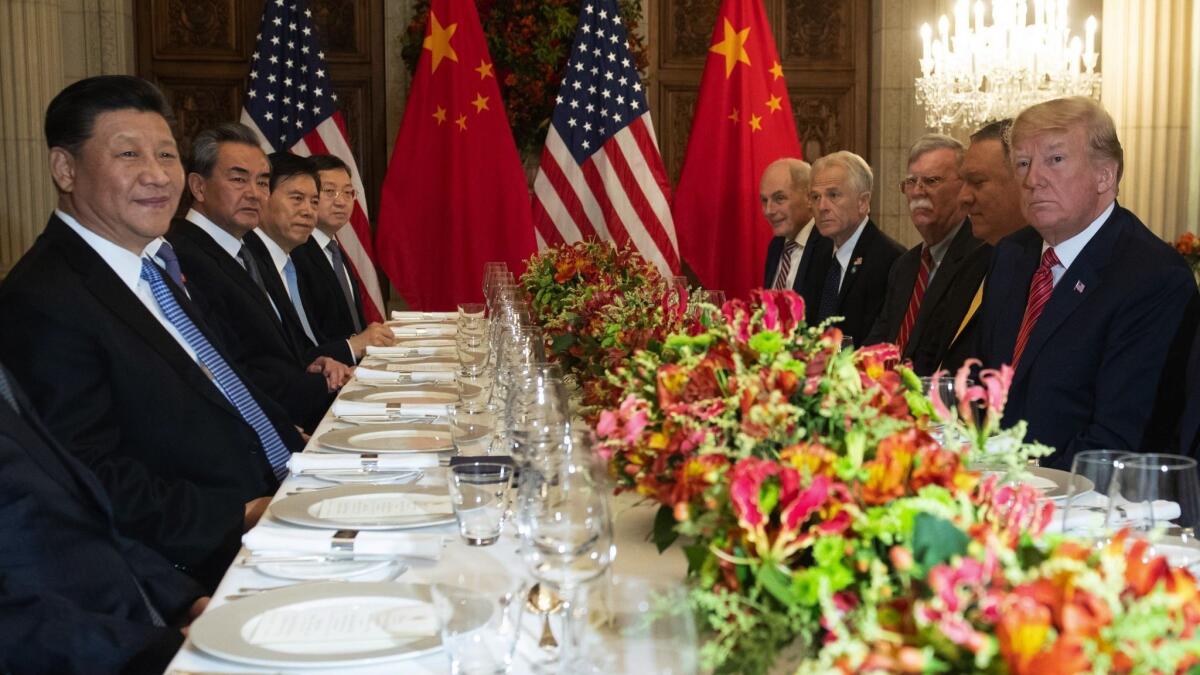The story alleging insider trades on Trump actions is dubious, but so is this argument against it

- Share via
The Wall Street and political junkie arms of Twitter are, well, all a-twitter over an article in Vanity Fair implying that someone has been pocketing billions by front-running sudden policy shifts by President Trump.
We don’t want to spend too much time debunking the article, which has been dismantled in detail by others, including Matt Levine of Bloomberg (a former investment banker) and futures market experts such as George Pearkes.
But we do want to take aim at one of the recurrent arguments appearing in the debunkings, which is that “every trade involves both a buyer and a seller,” and, therefore, the impulse of one side is exactly canceled by the impulse on the other. In other words, if someone has inside knowledge on which he or she is trading, then someone else must have equivalent motivation for taking the other side. Ergo, no story.
There is definite hanky-panky going on.
— Vanity Fair
That’s a very flawed argument, which we’ll return to in a moment.
First, the Vanity Fair assertion. Author William D. Cohan, himself a former investment banker, took aim at a number of trades in the market for Standard & Poor’s 500 futures and matched them against moves by Trump or other events that moved the stock market sharply and suddenly — Trump swerves on tariff policy, the drone strike on Saudi Arabia oil installations, etc., etc.
Vanity Fair called these trade “fantastically profitable,” and Cohan quoted a futures trader, anonymously, as saying, “There is definite hanky-panky going on.” Cohan made a similar claim back in July too.
Shed a tear for Lawrence Kudlow, Arthur Laffer and Stephen Moore.
As it happens, there’s no evidence to support Cohan’s picture of the futures trading. Market traders say he’s conflated what could be thousands of individual trades into single transactions, and that his assertion that the trading volume spiked suspiciously just prior to market-moving events doesn’t hold water. The volumes aren’t unusual overall, and one of his target dates was the last day of a quarter, when lots of activity takes place for legitimate portfolio reasons.
Moreover, there’s absolutely no evidence in Cohan’s stories, or elsewhere, that someone with connections to the White House has been trading on information about Trump’s chaotic policy-making. That’s especially so given that some of the trades involved events almost certainly outside White House knowledge, such as the drone strike and statements about the trade war coming from China that appear to have blindsided Trump along with everyone else.
So we can set the Vanity Fair allegations aside. But what about the buyer-and-seller argument?
So, another high-flying company is being pummeled in the stock market.
At some level it’s true, of course, that every security or futures contract that’s bought must have a seller on the other side, and vice versa. But that doesn’t mean that both sides come to the transaction with equivalent motivations, or that they balance each other out. In his cogent deconstruction of the Vanity Fair piece, Felix Salmon explains that instead of calling one trade a sale and another a buy, Cohan could have just as well called the first a buy and the second a sale, since there were traders on both sides in both transactions--in other words, implicit in Cohan’s analysis is the erroneous idea that the buyers and sellers came to the market with equivalent, if opposite, motivations.
To take one of Cohan’s sample trades, “someone” sold short 120,000 S&P e-mini futures hours before the drone strike Sept. 13; when the market opened the following Monday, the S&P 500 index fell sharply, ostensibly earning that mysterious trader or trading group a nine-figure profit. (The e-mini is an electronically-traded future one-fifth the size of a conventional futures contract on the S&P 500 index.)
Yet the short sale of 120,000 contracts doesn’t mean a single trader bought the same contracts. For all anybody knows, the sellers, if they existed, assembled their short position from thousands of traders on the other side. Sure, for every contract, there was a seller and a buyer, but the number of sellers didn’t have to equal the number of buyers, and almost certainly did not.
It should be obvious that this trope doesn’t hold true anywhere in the investment markets. If it did, there would be no reason to prosecute insider trading, since buyers and sellers would come to the market with eyes equally open. That’s not how things work: Trades are typically initiated by one participant, and the others react.
A stock buyer with inside information about a pending merger will buy on the expectation that the stock will soar. He or she has to find a willing seller, who presumably isn’t privy to the same information. One can’t look at that transaction and say it must be innocent because there was a seller for every buyer.
So, yes. There are sound reasons to doubt the Vanity Fair claims, including the dearth of any concrete evidence for them. But the idea that there are sellers for every buyer isn’t one of them.
More to Read
Inside the business of entertainment
The Wide Shot brings you news, analysis and insights on everything from streaming wars to production — and what it all means for the future.
You may occasionally receive promotional content from the Los Angeles Times.











